Myakka River State Park, formally established and opened to visitors in 1941, is one of Sarasota County’s unique and precious treasures. In late January, I had the opportunity to join a Florida Department of Environmental Protection biologist at Myakka River State Park to survey 14 miles of the Myakka River by kayak, to better understand the state of the river and the wildlife it supports, as well as some of the conservation issues this spectacular ecosystem faces.
In the blog series “Wild and Scenic”, you can experience a day in the life of a biologist on the Myakka River and get an inside perspective on what’s going on “beneath the surface”. Read part 1 of the “Wild and Scenic” blog series to learn more about the history of Myakka River State Park and the river’s Wild and Scenic state designation.

Meet Chris

This is Chris Oliver, Florida Department of Environmental Protection’s Myakka Wild and Scenic River Biologist. After years of kayaking a 14-mile stretch of the Myakka River each month, he manages to paddle swiftly down the river, maneuvering with the current, and avoiding the submerged trunks of cabbage palms. He steers clear of overhanging thickets of branches and leaves, and does this, all while capturing numbers of each bird species, alligator, turtle, and snake seen and heard along the way, in a small waterproof notebook.
Sound impossible? With practice, repetition, an observant eye, and of course, years of expertise, carefully camouflaged creatures reveal themselves, birdsong that drifts in on a warm breeze gives away the location and identity of its vocalist, and just a fleeting glimpse of a feathered body as its wings carry it away is enough to know- tricolored heron or little blue?
Biologists systematically and routinely survey sections of an ecosystem to look not only for the presence of wildlife, but also to document plant diversity and growth, evidence of damage, disruption, and pollution, the presence of invasive species, and much more. Chris’ role as Myakka’s Wild and Scenic River biologist is to monitor the ecosystem’s health, as well as the impacts of human use and activity in the ecosystem to inform the Myakka River Management Coordinating Council’s management and conservation decisions.
A “River’s-eye View”
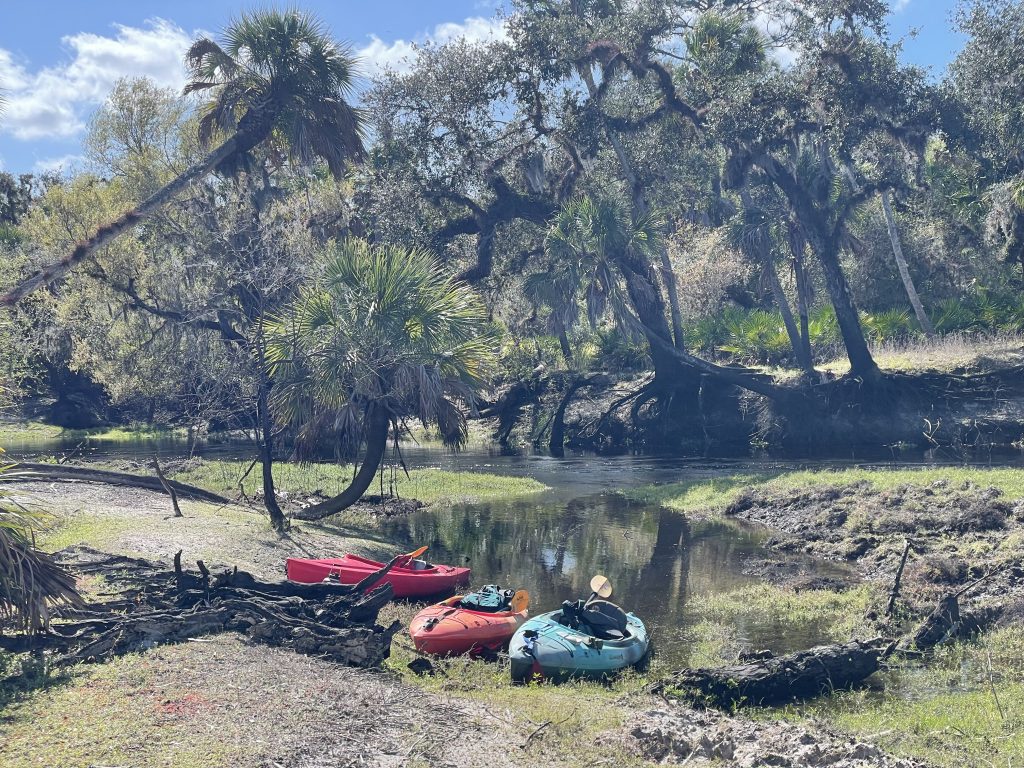
I arrived at the South entrance to Myakka River State Park at 8:00am on a pleasant and calm Tuesday in January. The morning’s clear skies and dry weather were welcome conditions amidst a very wet dry season. Chris and Ben, a Myakka River State Park volunteer who often accompanies Chris on his surveys, were waiting for me with three kayaks at the river’s muddy edge. After a short safety briefing, we pushed off and let the slow-moving current carry us as a black vulture flew overhead.
Despite having spent the past few months educating 4th and 5th grade students from Sarasota County public schools at Myakka River State Park through our LIFE program, and visiting the park sometimes 4 times a week, experiencing the landscape from a “river’s-eye view” opened up a whole new world for me. Each bend and section of the river offered something beautiful, intriguing, and novel.

Spectacular Sights
The water itself, with its rich, deep, bronze color, sparkled and glistened in the mesmerizing way that only blackwater rivers do. Golden rays of sunlight illuminated the varying shades of green in the diverse collection of plant species present along the river’s banks.
In some sections, the river narrowed and snaked forward, while in others, it opened up into a wide lake, with wind, waves, and stronger currents pushing me to paddle hard and hope that I didn’t end up in the water! At times, the sloping trunks of cabbage palms draped over the surface, creating obstacles to navigate, and resulting in a few run ins with leaves and palm fronds full of spider webs.
The Impact of Invasive Plants
Shortly into the 14-mile journey to our end point at Venice Myakka River Park, we paddled through a section of the river where tall, thick grass towered overhead and made seeing anything on either side of the river impossible. “Paragrass”, said Chris, as he detailed how this invasive species of grass takes over and alters critical habitat along the banks of the river.
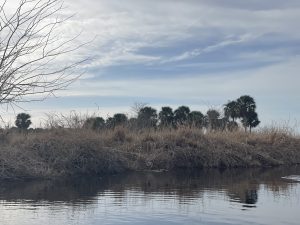
Invasive species create complex issues for Florida’s ecosystems and removing them is costly and labor intensive. In fact, Florida spends approximately 45 million dollars annually to manage invasive plants alone (Wells, 2023).
Chris explained the tactics used in partnership with Florida Fish and Wildlife Conservation Commission (FWC) to try to control paragrass’ spread and chokehold in the Myakka River’s floodplain- a combination of careful chemical application followed by prescribed fire.

More on Managing Invasive Plants
While herbicides, especially when misused, can have damaging consequences to an ecosystem, they are often the only feasible option for removing equally damaging invasive plants that have completely overrun large tracts of land.
It is next to impossible to restore acres of habitat by manually removing grasses and other invasive plants. These species often have vast underground rhizomes that store energy to re-sprout and spread with renewed force when disturbed. Land and natural resource managers select appropriate herbicides for the specific plants to be targeted with the least impact on non-target species.
We soon reached another section of the river that brought hope.
Restoration Brings Hope
The impenetrable wall of tall grass began to disappear and give way to blue skies and an expansive floodplain with visibility for miles. Floodplains are flat areas of land along rivers with plants and animals that are adapted to wet soils and changing water levels. These plants also help filter and clean water and allow water to percolate and recharge ground water levels.
Far off in the distance, a herd of deer galloped wildly along the edge of the forest with a freedom that is uncommon to see in our altered landscapes. On either side of us, peculiar stalagmite-like bunches of blackened grass rose from rich, saturated soil carpeted with the electric-green new-growth of native vegetation.

A Win for Wildlife

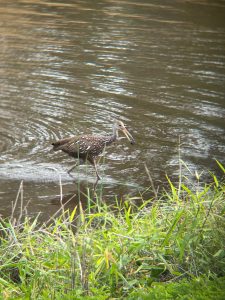
As a result of the application of these management techniques, where paragrass once dominated and diminished the available habitat for several species of native wildlife, we could now delight in watching a flock of killdeer foraging in the open floodplain’s mudflats.
Chris pointed out the silhouettes of limpkins searching for snails to snack on in the distance, and enthusiastically located an American kestrel perched atop a bare tree branch, scanning the expanse for prey. Without this restoration work, these animals would not have been able to utilize the area for survival.
With so many issues threatening our natural areas, witnessing wildlife returning to use a previously inaccessible area, and listening to Chris’ approving assessment of the project’s progress brought me a sense of hope and excitement.
In fact, in my enthusiasm, I found myself being carried by the current around a bend and to my surprise, right into a bunch of vegetation where a long, dark-colored snake was casually draped and sunning itself.
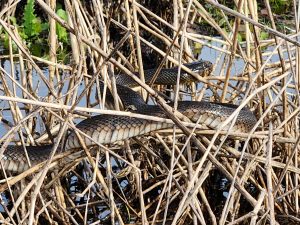
Sssurprise!
My eyes quickly scanned its head and body to determine whether I had just disrupted a venomous species’ R&R time. Elongated, slender body, rounded head and pupils, characteristic lines along the sides of its face and mouth- whew…not a cottonmouth.
Its patterning and coloration additionally gave its identity away, and as the current pushed me forward, I called out “water snake”. Behind me, Chris paddled over to snap some photos and identify it as a non-venomous green water snake (Nerodia floridana).
As a snake lover, this was one of the day’s highlights! Looking to improve your own snake identification skills? Visit our wildlife webpage for free webinars and a host of information.
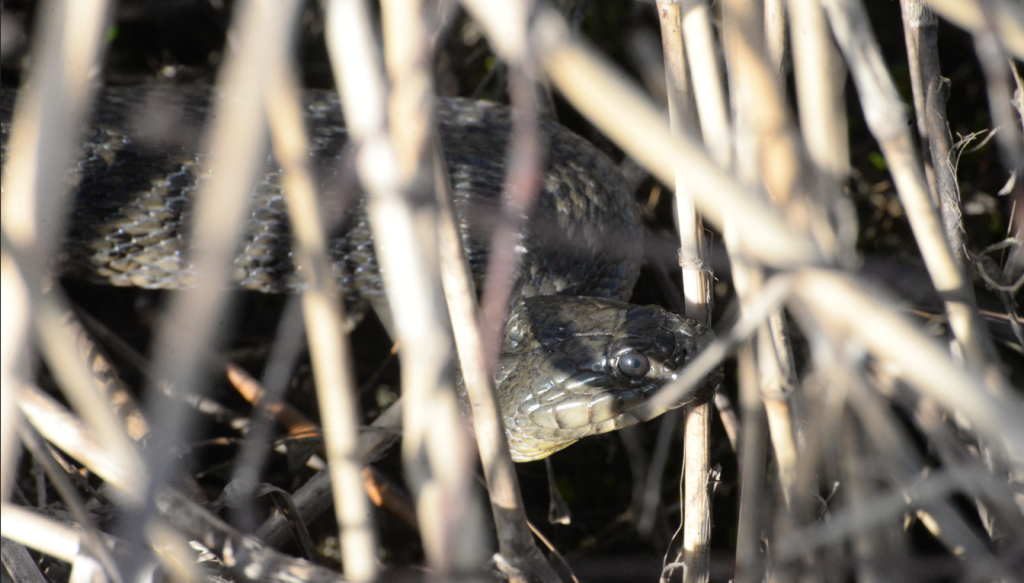
What Lies Ahead
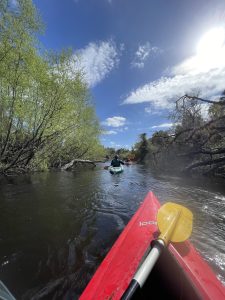
Our time in this spectacular section of the Myakka River was coming to a close, and ahead lay the Lower Lake and Myakka River State Park’s famed Deep Hole, a 131 ft. deep sinkhole famed for the high concentration of alligators that congregate in the deep, dark waters and along the sinkhole’s edge. Head over to part 3 of the “Wild and Scenic” blog series to read what happens next!
Find other blogs in this series here:
Wild and Scenic: A Day in the Life of a Biologist on the Myakka River Part 1
Wild and Scenic: A Day in the Life of a Biologist on the Myakka River Part 3
Wild and Scenic: A Day in the Life of a Biologist on the Myakka River Part 4
Sources
Wells, A. (2023, July 26). Action of the Week: Remove Invasive Plants. Florida Museum Thompson Earth Systems Institute. https://www.floridamuseum.ufl.edu/earth-systems/blog/action-of-the-week-remove-invasive-plants/
 1
1
